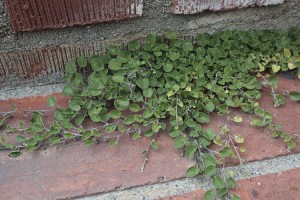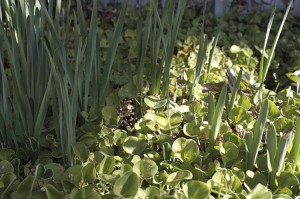My parents knew a good deal when they saw one. The house they purchased in the Southern California ‘burbs had the required number of bedrooms, fruit trees in the back, a lawn for the kids to play on, and was located half-way between their jobs. The front yards in the neighborhood were well maintained but not splashy.
Some of the houses on the other side of the nearby main boulevard, however, had immaculate high-maintenance gardens–and probably had gardeners to go with them. One of the groundcover choices that some of those houses sported was a dark green dichondra lawn, smooth and uniform as the felt on a pool table. These were lawns that didn’t tolerate much foot traffic, required lots of weeding, heavy summer water and were meant mainly for show. Compared to our lumpy, spiky lawn, these dichondra tableaux seemed like the stuff that dreams are made of. (We never would have considered that dichondra is considered a weed in many parts of the country.)
Jump ahead lots and lots of years to my current house. Every now and then in one of the raised beds I’d see a plant volunteer underneath some shrubs or around some bulbs. It sure looked like dichondra, but for a long time I thought I wasn’t IDing the plant correctly.
As it turns out the plant really is a dichondra, and it’s actually one of the uncommon native plants found in coastal sage scrub, chaparral and oak woodland habitats. The local species, Dichondra occidentalis, is distinct from the classic lawn plant–one of the subtle distinguishing characteristics being the silver or brown hairs on the stems. But it’s still a dichondra, and I thought its was pretty cool that one of the plants that I’d fetishized growing up somehow managed to find me as an adult.
The dichondra has self-sowed itself into a couple spots around the house. It now forms a welcome groundcover in this raised planter, where a few months ago the narcissus were breaking through the soil…
…and this is today, with white Chinese ground orchids, Bletilla striata alba, blooming away in their bed of soft dichondra.
If you don’t want to wait for the plant to show up on its own, several California native plant suppliers offer Dichondra occidentalis, though it’s definitely one of the less popular items. The plant seems best for me in part-shade. It can take the summer off if you don’t water it, but bi-weekly sprinklings have kept it around year-round for me, though in summer it’s a little sparse. But as much as I hate to admit it, I also have a hard time looking glamorous all the time, so I’m willing to give this plant a break…



